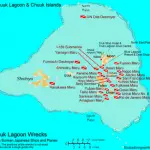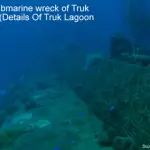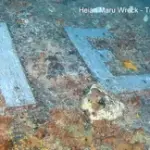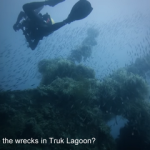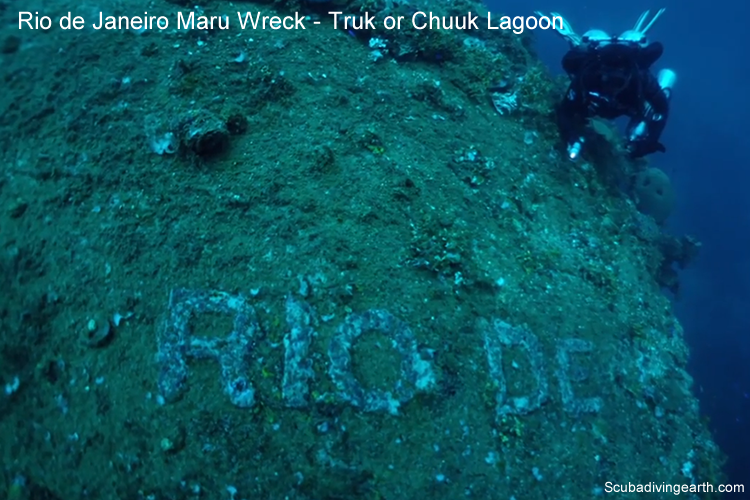
The Rio De Janeiro Maru was sunk during Operation Hailstone in 1944
This short article is to provide you with a few basic details about Japanese World War II wreck Rio De Janeiro Maru wreck, which is one of the many Truk Lagoon wrecks for scuba divers to enjoy in Chuuk Lagoon.
Scuba dive the Rio De Janeiro Maru Wreck of Truk Lagoon: Scuba diving the Rio De Janeiro Maru Wreck of Truk Lagoon is suitable for recreational divers as the maximum depth is 33 metres (110 feet). The top of the wreck is just 10 metres (35 feet) below the surface. A passenger ship on its starboard side with a large stern gun, large gun turrets and gun barrels in holds.
The best way to dive Truk Lagoon is by a scuba diving liveaboard. You can check the latest and best deals on Truk Lagoon liveaboards using the following window:
Truk Lagoon dive liveaboards table
This list of Truk Lagoon liveaboards is in descending customer rating order, followed by Scuba Diving Luxury Rating (SDE Lux Rating, see below), so the liveaboards with the highest customer rating and the best SDE lux rating will be at the top of the list. If you want to change the list order, use the “Sort by” dropdown below.
| Discover Liveaboard | Customer Rating | SDE Lux Rating % | Flexible Booking | Dive Courses | Dietary Requirements | Nitrox | Gear Rental | |
|---|---|---|---|---|---|---|---|---|
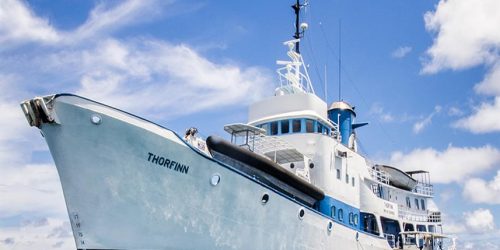 |
Review: SS Thorfinn; Book: SS Thorfinn | 8.8 | 88% | YES | YES | YES | YES | YES |
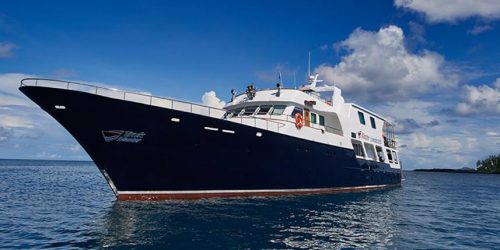 |
Review: MV Truk Master; Book: MV Truk Master | 7.9 | 65% | YES | NO | YES | YES | YES |
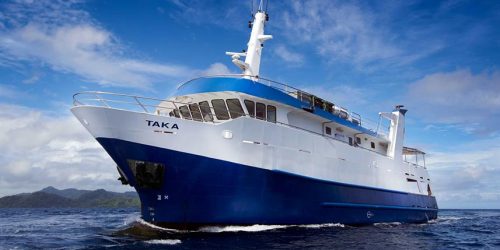 |
Review: MV Pacific Master; Book: MV Pacific Master | 0 | 56% | YES | YES | YES | YES | YES |
The Scuba Diving Earth Luxury Rating (SDE Lux Rating) is explained on each liveaboard review when you click the “Discover Liveaboard” link, and is my own Liveaboard Luxury Rating I’ve assigned to all liveaboards. Choosing between liveaboards is helped by customer scores, and if you get stuck choosing between two or three liveaboards, where each one has a high customer score out of 10, you can use the SDE Luxury Rating to help narrow down your choice.
Think about it like using Booking.com when searching for the best hotel. Booking.com also use a customer score where each customer rates hotels out of 10. This is similar to the liveaboard customer rating, which is also rated out of 10. But let’s say you only like to stay in hotels rated 8 and above on Booking.com, but you also want the hotel to have WIFI or parking, or to have a swimming pool etc. The features each hotel has is usually secondary to the score out of 10.
Truk Lagoon is the name these Pacific lagoons and islands were named in 1944 when they were in Japanese occupation. However, the name of Truk Lagoon was changed in 1990 to Chuuk Lagoon.
Scuba divers seem to use these two names synonymously. Whilst the correct name is Chuuk Lagoon, at the time Rio De Janeiro Maru was sunk, which is now dived by scuba divers across the world, it was named Truk Lagoon.
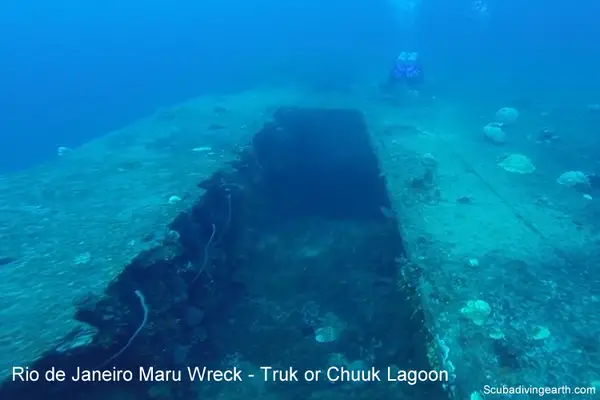
Details of Rio De Janeiro Maru wreck dive of the Truk Lagoon
The Rio De Janeiro Maru wreck dive was a converted submarine tender originally. But then after the majority of the Japanese submarine fleet were almost but destroyed, she was reconverted to a transport vessel instead. The word ‘Maru’ in Japanese ship naming protocol designates a merchant vessel.
- She was originally built in 1930.
- Prior to the war she was an eight-deck passenger liner for one of the largest Japanese shipping companies, the Osaka Shosen Kabushiki Kaisha (O.S.K. Line).
- Has large deck guns, which were installed when she was first converted to a submarine tender.
- There’s abundant see life, great visibility (see video below).
- Also a large number of artefacts to be found on this wreck.
- This wreck is one of the shallower Chuuk Lagoon wrecks.
- The top of the wreck is in about 10 metres (35 feet) of water.
- The deepest point of this dive is 33 metres (110 feet).
- Rio De Janeiro Maru wreck dive is an achievable dive for recreational divers with the relevant certification for this depth and experience.
More Reading: Recovery of the Junkers Jumo 211 (recovery of underwater artifacts)

30+ metres is still deep diving
A 33 metre wreck dive isn’t shallow. Your maximum no decompression stop time at this depth is going to be between 14-20 minutes on normal air. However, what I’d recommend is getting yourself on a Nitrox Course and dive with nitrox, as many of the dives in Truk Lagoon can be dived on nitrox. This is bearing in mind the depth limitations that a Nitrox mix creates.
But with a 32% air mix at 33 metres (110 feet) your dive time will be increased to 25 minutes. This will allow you more time to enjoy the Rio De Janeiro Maru wreck without going into decompression stop time. But as always I’d recommend a safety stop on all dives in any case.
Rio De Janeiro Maru – the stats
- She is lying on her starboard side is in 10-33 metres (-210 feet) of water.
- Originally a passenger cargo ship, before being commissioned for World War II by the Japanese navy.
- She measured 141 metres (461 feet) and had a beam of 19 metres (62 feet).
- Her weight was 9,626 tons.
- This makes her the fourth heaviest wreck in Chuuk Lagoon.
- This large vessel was propelled by twin propellers.
- The propellers were driven by two 6-cylinder 2-stroke Mitsubishi Sulzer diesel engines.
- She could carry a complement of 150 crew members together with 1,140 passengers.
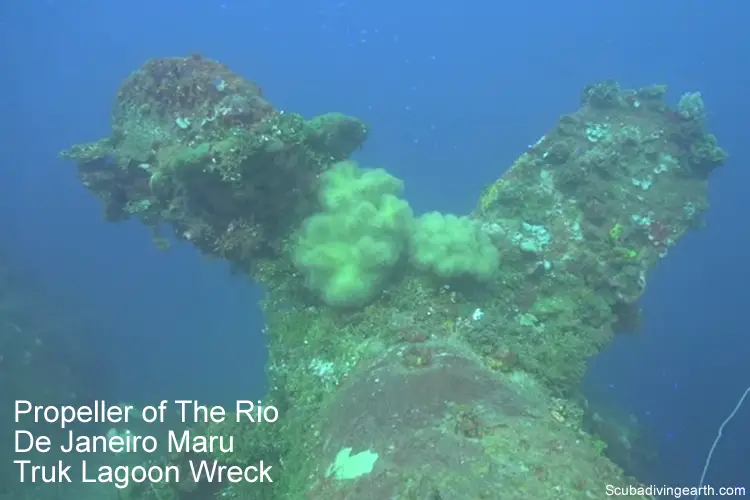
Comments on Rio De Janeiro Maru wreck
It was on 17th February 1944 that the Rio De Janeiro Maru was bombed during Operation Hailstone. But it wasn’t until around midnight on 18th February that she finally sunk.
The attack came from U.S.S. Yorktown and U.S.S. Bunker Hill. She was sunk by one or two 1,000 lb. bombs on the first day of Operation Hailstone air strike of Japanese naval base Truk Lagoon. She now rests 411 metres (450 yards) from the shore on the east side of Uman Island.
This is an easy wreck to explore, both externally and inside her engine room and holds. This is because there are a number of explosion holes from when she was attacked by American Forces in 1944.
But as always take great care when entering a wreck. Remembering that she was sunk back in 1944 and there’s plenty of rust and corrosion taken place. Be mindful of stirring up silt too.
One thing you find plenty of inside the Truk Lagoon wreck are plenty of crates of beer bottles.
To see its location on the map, please follow this link to: Truk Lagoon wreck map.
To understand more about what happened at Truk Lagoon, please take a read of this article what happened at Truk Lagoon in 1944.
Rio De Janeiro Truk Lagoon wreck video
This is a video of the Rio De Janeiro Maru Truk Lagoon wreck.
Join Blue Lagoon Dive Shop & Resort diving the world famous wrecks of Truk Lagoon, Micronesia. P
I hope you enjoyed this article about Truk Lagoon wreck Rio De Janeiro Maru
I’d love to hear from you. Tell us about your adventures of diving and snorkeling, in the comments below. Please also share your photos. Either from your underwater cameras or videos from your waterproof Gopro’s!
If this article hasn’t answered all of your questions. If you have more questions either about snorkeling or scuba diving (or specifically about Rio De Janeiro), please comment below with your questions.
There will also be many more articles about scuba diving (and snorkeling) for you to read and learn about these fabulous sports.
Have fun and be safe!

